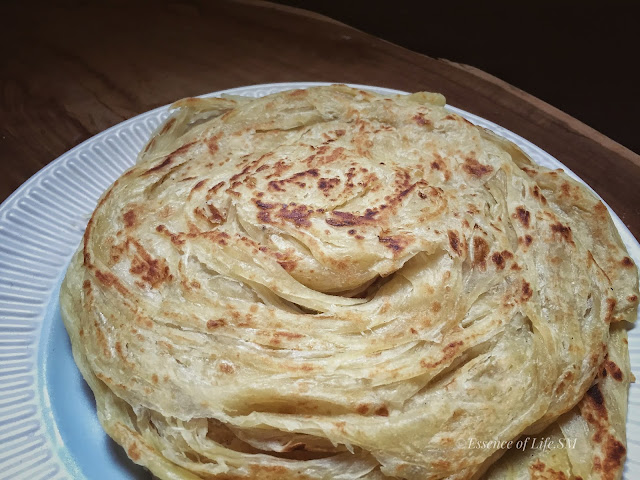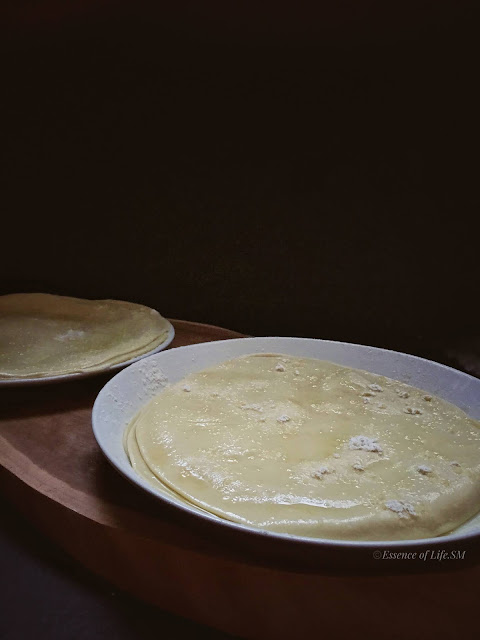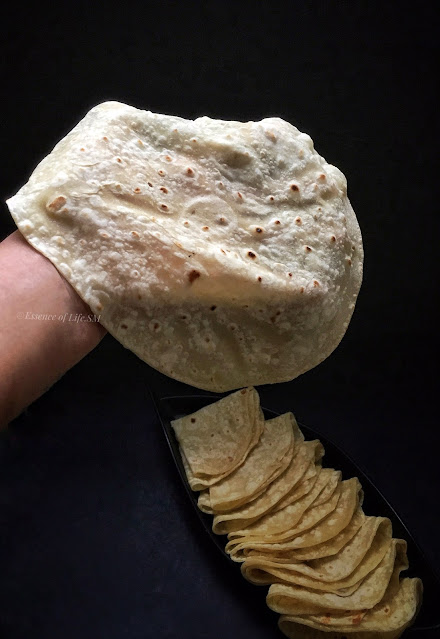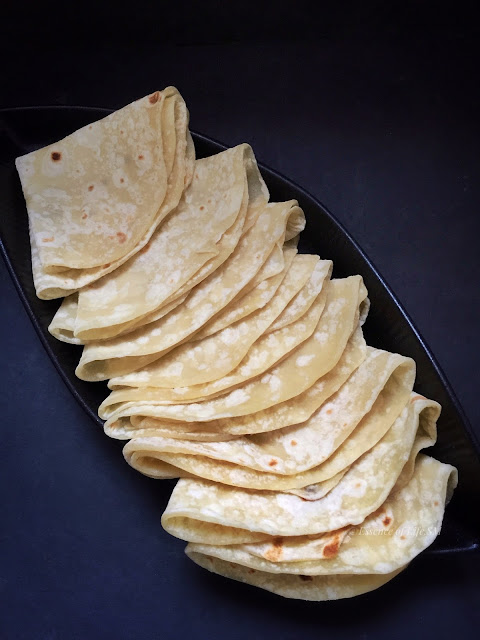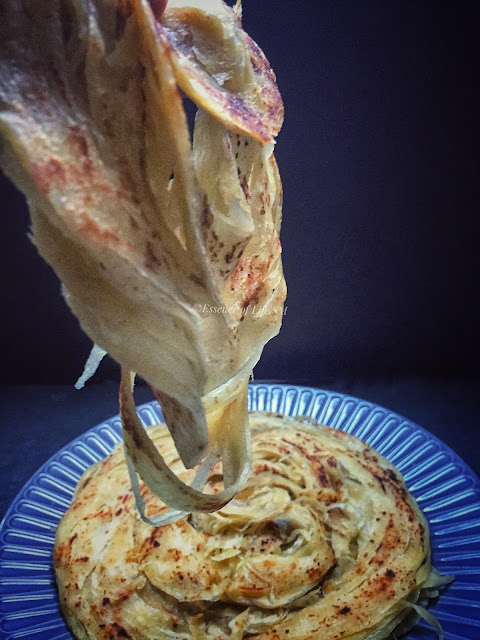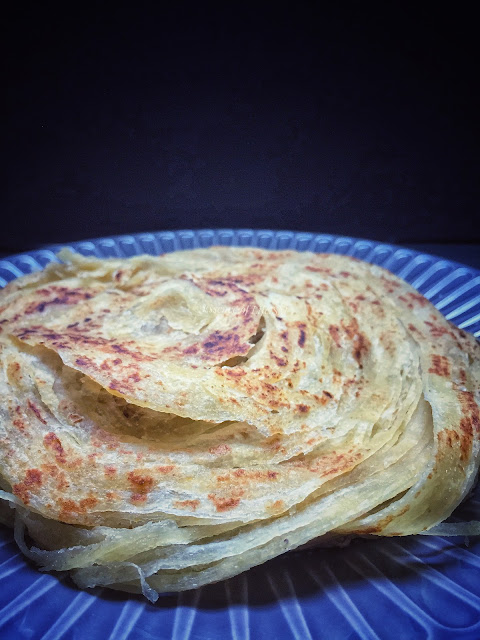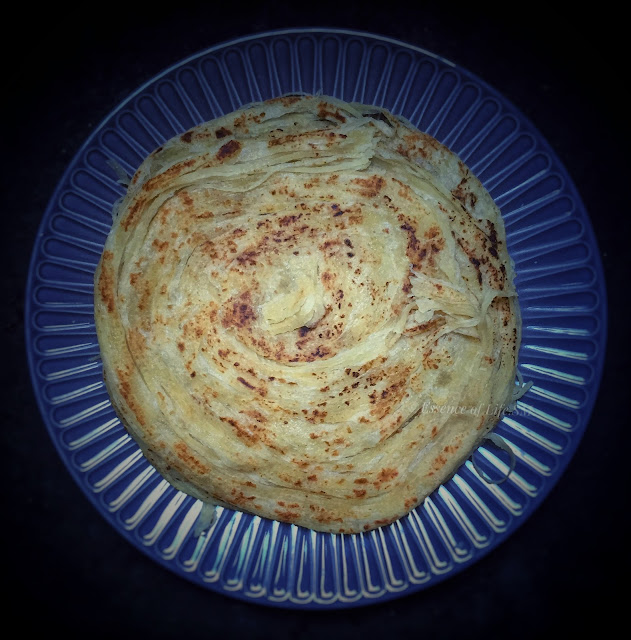PAROTTA |
Its found in every Kaiyendhi/Thattukada (small restaurants selling food in road sides), mostly in a Thallu vandi (its a trolley like mobile vehicle which has just a plank on top with four wheels underneath). Such Eatery Joints mostly pop during nights in cities selling Dosa, Idlis, Parottas, Omelettes etc., The variety of Parottas are quite versatile - Egg Parotta, Veechu Parotta, Coin Parotta, Poricha Parotta, Ceylon Parotta, Madurai Parotta, Kerala/Malabar Parotta. Each having its special ingredients and style of cooking.
Parottas are called as Rotis in Malaysia. The plain ones - Roti Canai. The variation in Roti Canai in Malaysia is far more versatile, it's served either as a savoury or as a sweet with variety of toppings or fillings like Roti Telur (Egg), Roti Sardine, Roti Pisang (Banana) Roti Bawang (Onion), Roti Bomb (filled with Sugar and Margarine and served with a drizzle of Condensed Milk - which is surely for the Sweet Tooth), Roti Kaya ... the list goes on and on. Sometimes the sweet varieties of Rotis are topped with , peanut butter, jam and nutella and served without the curry. The savoury versions of Roti are traditionally served with Dhals or with Fish, Chicken or Mutton Curries. Most of the restaurants serve a small blob of Sambal along with these curries.
I was in a long trial to master a perfectly layered, crispy and flaky Parottas, but to my surprise it was easier than I imagined. Most recipes looked more or less similar, the essential ingredients being All-Purpose Flour/Maida, Salt, Oil and Water. In addition to these some recipes call for milk, egg, butter or baking soda. I felt that milk and egg makes the Parotta too rich for its nature. Adding Baking soda makes Parotta thick and tough, most of all if I couldn't get the desired flavour or texture. Too much oil and butter can make your Parottas crispy.
As always - "Simple recipes are always the Best" according to my theory. And my foolproof recipe turned out to be with only the basic ingredients. But the secret behind Perfect Parrota are 3 most important techniques :
- The first being the resting periods between Kneading, Shaping and Rolling.
- Next - Moisture the dough by smearing oil over the shaped dough balls instead of adding oil while kneading the dough.
- Then comes the perfect shaping technique, which yields flaky Parottas.
In addition to the basic ingredients, I have added sugar for a tinge of sweetness which all of us at home like. Then I let the dough mix rest along with water for few minutes before kneading the dough which would soak up the additional moisture and reduce the stickiness synonymous to the All-Purpose flour. My kneading job also got easier by doing so yielding stretchy dough. The resting periods between kneading and shaping really helps in developing the gluten needed. Smearing oil over the shaped dough balls keeps them soft and moist. The dough relaxes and becomes a wonderful pliable dough easy to handle and shape.
Though easy making Parottas are time-consuming, but the fruit of the toil is worth a try!
PAROTTA WITH EGG AND CHICKEN GRAVY |
Parottas taste best along with spicy Vegetarian or Non-Vegetarian curries. Mutton or Chicken Chalna/Saalna is the best combination served mostly in restaurants. For a vegetarian combo Vegetable kurma suits the best along with Parottas. But according to all of us at home, if its Parotta - its Coimbatore famous - Burma Bhai's Parotta and his one and only Egg and Chicken Gravy. I have always tried to replicate this curry which is his secret recipe.
Cuisine : Indian
Course : Main Course
Serves : 4
Yields : 6-8 Parottas / Roti
Author : SM
Preparation Time : 20 -30 Minutes
Leavening Time : 1 Hour
Cooking Time : 10 - 20 Minutes
HOW TO MAKE PAROTTA / ROTI CANAI
 |
| PAROTTA / ROTI CANAI |
INGREDIENTS:
For Parotta/Roti Canai:
All-Purpose Flour / Maida - 2 CupsWater - 125 Ml (more or less)
Sugar - 3 Tspns
Salt - To Taste
Oil - To smear, Shape and Cook
METHOD:
For the Dough:
- Mix Sugar, Salt and Water in a cup until sugar and salt are well dissolved.
- Sift the All-purpose Flour once.
- Take the flour in a large bowl.
- Make a well in the middle and pour in the Salt-Sugar mixture.
- Stir well and keep it covered for 15 minutes.
- After 15 minutes, knead the mix into a pliable dough.
- Leave it aside for 10 -15 minutes.
- Grease your hands with few teaspoons of oil and knead the dough for 8-10 minutes.
- Adding oil at this will reduce the stickiness of the dough and easier to knead.
- After 10 minutes divide the dough into equal parts and roll them up into a ball.
- Rub oil generously over the dough balls, cover them with clean and wet kitchen towel and leave it aside for 30 minutes.
- Grease your work surface with oil.
- Take a dough ball on the work surface, gently press it with your palm and flatten them.
- Roll the dough until it turns into a thin sheet, make sure not to tear the dough.
- Use some oil to roll the dough.
- Slowly remove the thin dough sheet with your hands and gently pull on the edges.
- If the dough is in perfect consistency then it wouldn't tear much.
- Stretch the sheet from all direction (without tearing) until it becomes thinner and thinner.
- Smear some oil over the stretched sheet with your hands or using a brush.
- Gently lift the rolled sheet and fold them into pleats until they are folded into a long strip.
- From one end coil the folded strips around itself into a spiral.
- Tuck in the loose ends.
- Again smear oil over the coiled dough and leave it aside for 10 minutes.
For Parotta/Roti Canai:
- Meanwhile, heat the griddle in high flame.
- Roll the coiled dough with a rolling pin or just by gently pressing them with your palm to make a perfect round shape.
- Place the rolled Parottas on the hot griddle and cook one side.
- Lower the flame slightly and turn the parotta once and cook on the other side.
- Drizzle some oil over the parottas while they are cooking.
- Wait until small golden spots start to pop around.
- Once cooked they will be crisp on the outside.
- Follow the suit for rest of the parottas and keep them stacked.
- Once done slightly crush the stack with both your hands.
- This is to ensure that the layers are separated and the parotta is flaky.
NOTES:
- Use more water if necessary, while kneading the dough.
- Can substitute half the quantity of water with milk, if you prefer a rich texture.
- Adding sugar is truly optional.
- Use oil to roll the dough instead of flour.
- While rolling the dough balls, it should stretch easily. Few small tears are fine.
- If you mess up with the dough while rolling, roll the dough again and leave it aside for 5- 10 minutes before starting over again.
- It's equally important to grease the dough balls and leave them aside for at least 10 -15 minutes at every stage.






